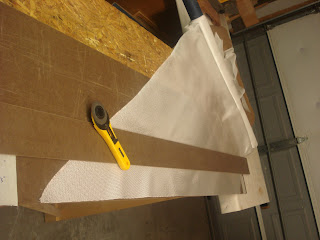Updates are added in
blue text and the photos are new.
Boat building is bound to have it's aggravations. I've found three. I'm only revealing these issues for completeness, each of them is not that big of deal in the big scheme.
Starting with the smallest; a small area (2" by 4") of plywood on the starboard side around frame 169 began to delaminate it's outside ply. What disappointment when you spend the extra money on high quality materials. I think this was all caused due to a small flaw in the outside layer of wood, mixed with the high induced stresses from bending, and mixed with the cyclic temperatures and humidity in the garage. This area has already been repaired by glue and proper clamping. I've inspected the entire rest of the hull and haven't found any other areas of concern.
Update; the image below is the repaired area.
For the second issue; when I cut out all of the frames I followed the templates. Well the templates for the outboard edges of each frame were straight. Upon inserting the frames into the boat a gap appeared between each outboard edge and the hull's side panel. The fix for this is to template the side panel's curvature into the frame, glue a strip of plywood (approximately 3/4" wide) onto each side of the frame, and cut the frame to match the templated curve. On the the first frame I've installed, frame 18, this worked perfectly on the first try.
Update; I happen to replace frame 53.5 and the image below shows the issue best. For the other five frames I added a sliver piece between the frame and hull side panel.

Lastly, when building the strong-back, the cradle glued to the floor, I paid great attention to determining the height of each frame relative to the baseline string. Well mistakes were made, several of the cradles supports have gaps between them and the hull bottom. So, I'll take a step backwards, lift and support the boat off of the cradle, 3'ft high, adjusting the cradle's support position, and lowering the boat back into the cradle. This will take awhile. For the record the proper dimensions for each frame are as follows: Stem - 6.4", frame 18 - 4.75", frame 53.5 - 1.95", frame 89 - 0.7", frame 110 - 0.84", frame 124 - 1.22" frame 169.5 - 4.15", transom - 7.93". These dimensions were obtained from the design owner who pulled them from the auto-cad files of the boat. Now for the truth, I'm now convince I don't even need this cradle. So far each of the hull's plywood panels and frames have lined-up within the wide of the 0.5mm pencil line reference marks taken from the templates. The boat is coming together extremely straight and the cradle is not necessary. I'm going to correct the cradle so the hull bottom can support my weight while gluing the interior. If I build another i550 I'm not going to bother with a cradle, instead I'll support the hull with foam mattresses and straps.
Update; The boat was light enough to lift and set on sawhorses. This allowed me plenty of room to rebuild the seven hull supports located under each frame. They are now evenly contacting the hull bottom.








































